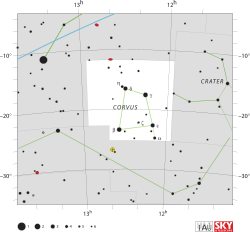Corvus (constellation)
Corvus is a small constellation in the southern sky. Its name is Latin for raven or crow. It has only 11 stars that can be seen without a telescope. It was one of the 48 constellations listed by Ptolemy. However, he only included 7 stars.[1] Corvus is one of the 88 modern constellations.
| Constellation | |
 | |
| Abbreviation | Crv |
|---|---|
| Genitive | Corvi |
| Pronunciation | /ˈkɔrvəs/, genitive /ˈkɔrvaɪ/ |
| Symbolism | the Crow/Raven |
| Right ascension | 12 |
| Declination | −20 |
| Quadrant | SQ3 |
| Area | 184 sq. deg. (70th) |
| Main stars | 4 |
| Bayer/Flamsteed stars | 10 |
| Stars with planets | 1 |
| Stars brighter than 3.00m | 3 |
| Stars within 10.00 pc (32.62 ly) | 1 |
| Brightest star | γ Crv (Gienah) (2.59m) |
| Messier objects | 0 |
| Meteor showers | Corvids (June 26) |
| Bordering constellations | Virgo Crater Hydra |
| Visible at latitudes between +60° and −90°. Best visible at 21:00 (9 p.m.) during the month of May. | |
Special features
changeStars
changeFour principal stars, δ, γ, ε, and β Crv, make a group of stars called "Spica's Spanker"[2] or "the Sail".[3][4]
31 Crateris (which was originally numbered in Crater) is a 5.2 magnitude star which was once mistaken for a moon of Mercury.
Deep sky objects
changeCorvus has no Messier objects.
The Antennae galaxies are made up of two galaxies that are colliding, NGC 4038 and NGC 4039. It has a heart shape as seen from Earth. The name name comes from the huge tidal tails that come off the ends of the two galaxies.
There is a planetary nebula NGC 4361 at the center of Corvus. The nebula looks like a small elliptical galaxy, but it is not. The center star is only magnitude 13, so it cannot be a large galaxy.
Mythology
changeThe story of Corvus is related to two other constellation, Crater and Hydra.
Once the crow had beautiful silver or snowy white feathers and could speak to humans. The crow was a very special bird for the god Apollo. When Apollo's lover Coronis was pregnant, Apollo told the raven to watch over her. Coronis slowly lost interest in Apollo and was attracted to a human. The crow had been spying on her secretly. He told Apollo that Coronis had a new lover. Apollo was so angry that he turned the loyal raven's feathers black and took away the bird's ability to speak. Coronis was killed by Apollo's twin sister Artemis. The child of Coronis and Apollo lived. He then became Asclepius, the god of medicine and healing.
In another story, Apollo sent his raven to get some water in the god's cup called the Crater. The raven waited for some figs to become ripe and ate them. He came back very late with a water snake called a Hydra and the water in the cup. The foolish raven said he was late because of the water snake. Apollo was not tricked. He put the raven in the sky along with the water snake and the cup. The snake stops the thirsty raven from getting to the water in the cup. The raven can see the water, just out of reach.
Origins
changeCorvus is similar to the Babylonian raven (MUL.UGA.MUSHEN). The Babylonians also put the raven sitting on the tail of a snake. The Babylonian constellation was special to the god Adad. Adad was the god of rain and storms. In the time of the Babylonians, the constellation would have risen just before the start of the autum rainy season.[5]
Notes
change- ↑ Chambers, Ephraim, ed. (1728). Cyclopaedia, or an Universal Dictionary of Arts and Sciences (first ed.). James and John Knapton, et al.
- ↑ Nickel, J., (1999): Lift Up Your Eyes on High: Understanding the Stars, Christian Liberty Press, p. 53.
- ↑ Bakich, M. E., (1995): The Cambridge Guide to the Constellations, Cambridge, Cambridge University Press, pp. 21,22.
- ↑ Mullaney, J., (2007): The Herschel objects and how to observe them<Astronomers' Observing Guides>, Springer, p. 39.
- ↑ Babylonian Star-lore by Gavin White, Solaria Pubs, 2008, page 166ff
References
change- Ian Ridpath and Wil Tirion (2007). Stars and Planets Guide, Collins, London. ISBN 978-0007251209. Princeton University Press, Princeton. ISBN 978-0691135564.
- Richard Hinckley Allen, Star Names, Their Lore and Legend, New York, Dover.
- Thomas Wm. Hamilton, Useful Star Names, Viewlex, Holbrook, New York, 1968.